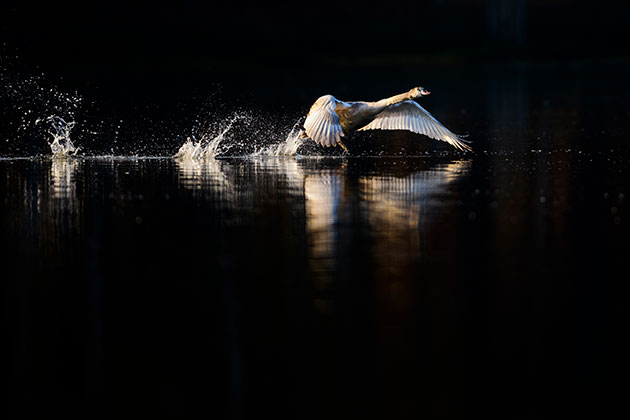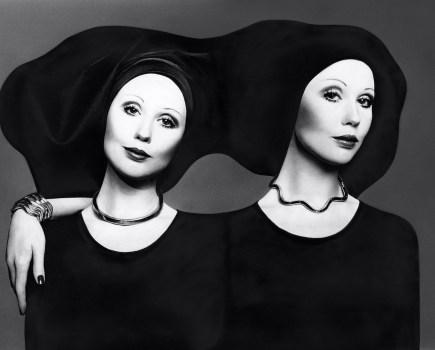On any form of photography, lighting can have a big impact on the resulting images, and can elevate a good image to a fantastic one. There is no ‘best’ type of light, but by utilising the various forms you can create a much wider range of images. Photographing wildlife outdoors means you cannot alter the light as a studio photographer can, so you normally have to work with what you’re given and use it to your advantage as best you can. Although you can predict where the sun will be at a certain time of the day, predicting where your subject will be is a different matter! However, there are some actions you can take, particularly if you have a good idea of where your subject is likely to be.
The angle of the sun has a large bearing on images. In almost all cases, I prefer to shoot when the sun is lower in the sky as the light is much softer. When the sun is high in the sky, it can result in harsh shadows and highlights, and it is easy to lose detail in these areas. Whereas in winter the sun is low throughout the day, in summer the high sun in the middle of the day largely restricts photography to early mornings and late afternoons and evenings. Fortunately, this coincides with the period when wildlife is most active – or in the case of many invertebrates such as butterflies, most photographable – so it pays to concentrate your shooting around these periods.
The three main directions of light are front lighting, side lighting and backlighting. The great thing with digital photography is that you can experiment, pretty much for free, and you get instant feedback via your LCD screen. Each form of lighting won’t work in every scenario and for every subject, but try out various techniques on different subjects and in different situations and you’ll get an idea for what works best and what kind of look you prefer.
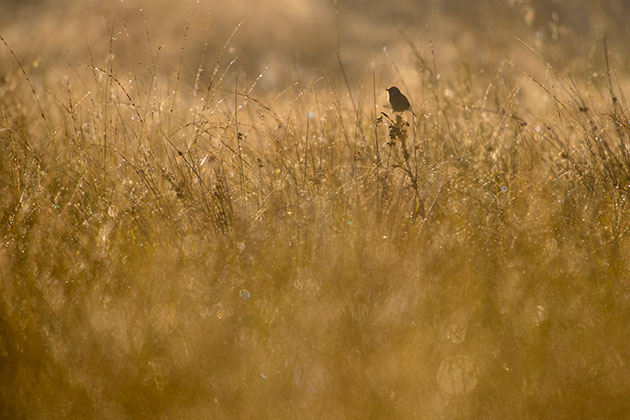
Shooting through dew-laden grass can produce some interesting bokeh. Nikon D800, 400mm with 2x teleconverter, 1/2500sec at f/5.6, ISO 500. Credit: Oscar Dewhurst
Using light creatively
Traditionally, the most common advice is to shoot with the sun over your shoulder. When the sun is low in the sky it should bathe your subject evenly in light and show o the colours best. It should also give a catchlight in the eye of your subject, which adds life to a photograph. Shooting with the sun behind you and a background in shadow can also create dramatic images as exposing for your illuminated subject should render the shaded background black, which can really emphasise colour.
While front lighting can result in lovely images that show off your subject’s beauty, they can also sometimes look like record shots, and it can be difficult to capture images that stand out in this lighting. Using different light angles such as from the side or behind allows you to create images that can appear much more imaginative and artistic, and you can be much more creative.

Exposing for the illuminated side of the owl enabled Oscar to get something a little different. Nikon D800, 600mm with 1.4x teleconverter, 1/500sec at f/5.6, ISO 1250. Credit: Oscar Dewhurst
Side lighting
Side lighting is, as the name suggests, when you photograph with the light coming in from one side. This results in images where one side of your subject is illuminated, and the other is in shadow. It can be used to great effect – although it works better with larger subjects. When using side light, I expose for the illuminated side of the animal, which places the other side in shadow.
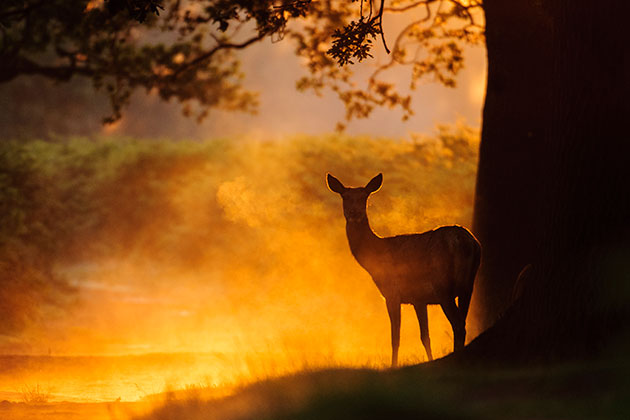
Shooting into the light when there is mist can be effective. Nikon D300s, 200-400mm, 1/400sec at f/4, ISO 640. Credit: Oscar Dewhurst
Backlighting
I love shooting into the light, known as backlighting. This can be an extremely effective technique, and I prefer it to side lighting as I find it to be more appropriate for a wider range of subjects. There are, of course, scenarios in which it won’t work and there are difficulties to consider, but when it comes off, backlighting can result in some spectacular images. When shooting into the light, there are a range
of different appearances that you can go for. One extreme is silhouettes, where you expose for the background, usually a coloured sky or water, at dawn or dusk. This renders your subject very dark or even black, and so tends to work best with subjects that have a recognisable outline.
Subjects that work well backlit
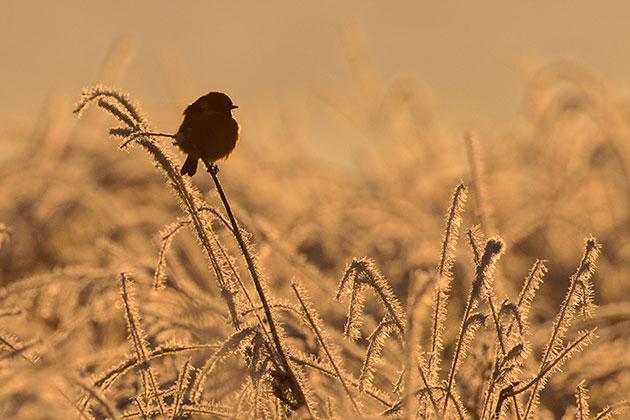
Credit: Oscar Dewhurst
Frost
I’m always watching the weather forecasts, and frost is something I look out for. Clear skies, calm winds and cool temperatures increase the chances of frost, which turns scenes into a winter wonderland. When the frost is severe, shooting into the light can look great, with the light passing through the frozen moisture that lines surfaces.

Credit: Oscar Dewhurst
Owls
Owls make great subjects to shoot with backlighting because the light can penetrate the tips of their wings, as seen in this image. As the bird flew in front of the setting sun with its prey, I had a brief window in which to capture images with the light how I wanted it. Fortunately, one of these images showed the wings in a nice upright position.
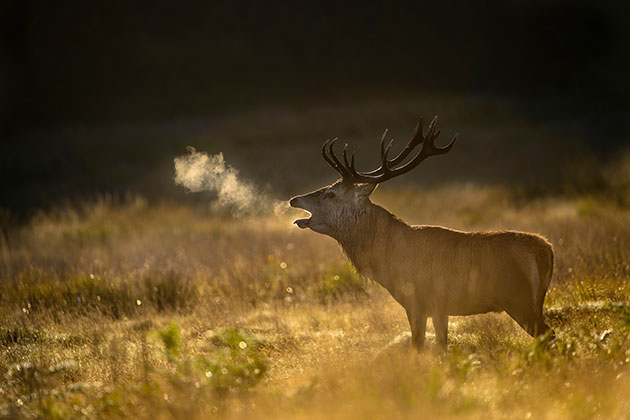
Credit: Oscar Dewhurst
Deer
During the rut – the annual autumn event when stags compete to mate with females – deer are a great subject to photograph into the light. They will often bellow as part of their impressive display, and if the conditions are right, their breath will condense as it hits the cold, outside air. Shooting into the light illuminates this wonderfully.
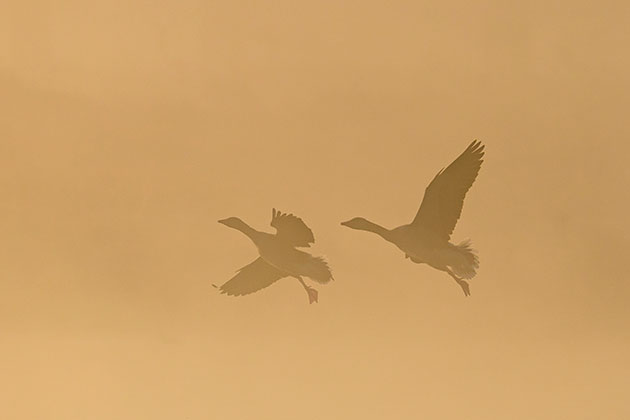
Credit: Oscar Dewhurst
Waterfowl
Birds often concentrate around water bodies, so I spend a lot of time photographing around such places, particularly if there is mist around. Photographing into the light with mist can look fantastic, as the mist will take on colour from the rising sun. When photographing birds on water, try to get to water level as it will throw your foreground and background out of focus.
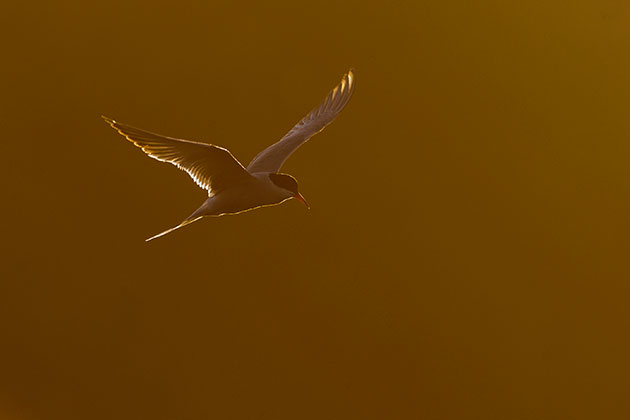
Credit: Oscar Dewhurst
Terns
Terns can work well with backlighting owing to the semi-translucent parts of their wings. On this occasion, while there is some light coming through the wing feathers on the near side, it is the rim-lighting effect around the edge of the bird that I was going for. I also like that some light can penetrate the beak, which retains some colour in the bird.

Credit: Oscar Dewhurst
Include the sun
Including the sun in the composition can be difficult, as unless it is very weak it is hard to avoid most of it blowing out. However, if the strength of its light is diffused by mist, you can retain most of the colour. In this image, exposing to keep detail in the colours of the sun meant that the grouse was rendered as a striking silhouette.
Rim lighting
You can also go for a rim-lit effect, where the edges of the subject are lit up. For this, the sun needs to be near the horizon. Rim lighting can work especially well with a subject on whom some light can penetrate parts of it, such as animals with fur. It also works well with birds, particularly those such as terns and owls which have semi-translucent wings. Any flying insects in the air will become illuminated, giving images a mystical appearance. When it is cold, condensation from the breath of animals will also be lit up, which looks great.
The way you position yourself in relation to the subject and the sun can have a significant effect on the appearance of the resulting images. The closer the sun is to the line between you and your subject, the more intense the contrast will be. However, if it is directly in line, you will be at risk of getting lens are, which can detract from the images.
Exposure is key when shooting backlit, but when photographing in this style, it is also subjective, and there are a range of appearances you can go for. One exposure extreme would be to expose for the main body of the subject, so the edges are overexposed, and the other is to expose for the edges, resulting in a much darker subject. Exposing for the edges is a good idea when you want to show off the shape and rim lighting, whereas if you prefer to keep some detail in your subject, expose for the darker areas. If you want to expose for these darker areas, spot metering can be very helpful, so the camera exposes for whatever your focus point is on. This is a good option if you are trying to expose for the main body of the subject. I tend to use manual exposure, however, as the tone of the subject can sometimes affect the meter reading.

With the sun largely behind him Oscar was able to make the most of the rich colours. Nikon D300s, 200-400mm, 1/400sec at f/4, ISO 500. Credit: Oscar Dewhurst
Checking the LCD
I still make sure that I regularly check the images on my camera’s LCD screen to ensure I’m happy with the results. If you prefer the histogram, remember that it will look very different from front-lit images, as it will probably have peaks on both the left and right sides owing to the shadows and highlights present, so I prefer to use the LCD screen to see if I’m pleased with the effect.
Bracketing exposures
One useful trick when shooting into the light is to bracket exposures; this means you could take three images, and adjust the exposure slightly each time, therefore giving you three different exposures (and three completely different appearances) to choose from when you review your images later on a computer screen.
When photographing backlit subjects, think about your background. Any bright areas will distract viewers from the resulting images, so it really is worth adjusting your position to avoid them if you can. Also, try to find a background that is a dark colour, so that the well-lit edges stand out more against the background.
Experiment
Hopefully this article will give you some ideas for what you could try when you’re next out photographing wildlife. The best advice I can give is to experiment; try out different light angles on a variety of subjects; this way you can find out what you prefer. As with all wildlife photography, please remember that the welfare of your subject must always come first.

The light coming through the wings of the owl, and the flies surrounding the bird, really make this shot. Nikon D800, 400mm with 2x teleconverter, 1/3200sec at f/5.6, ISO 1600. Credit: Oscar Dewhurst
Why it works
Over the years, I’ve spent a lot of time photographing wildlife along the Suffolk coast. I love it there – it’s such a contrast to London where I’m based, and the wildlife is fantastic. One species I’ve always been keen to photograph there has been barn owls, and a few summers ago I spent many evenings over a three-week period watching and photographing them as a pair of birds hunted over the grassland and marshland on either side of a country road. As I wanted to photograph them into the setting sun, I was restricted to photographing them on the side of the road where the sun went down. I would set up a couple of hours before sunset, and the owls were out most evenings, presumably with some hungry mouths to feed back at the nest! As the sun was approaching the horizon, I was desperately hoping for one of the birds to fly in line with the sun. Fortunately, this one did, and just as it was in the perfect spot, it suddenly turned and plunged straight into the grass. It was a magical moment. I really like the light coming through the wings, as well as all the tiny flies in the air that have been illuminated by the low sun.
Kit list
- Binoculars My binoculars are with me every time I’m photographing wildlife. Their clarity and lack of weight means they’re great for finding subjects, but when your subject is too distant to photograph it’s also nice just to watch sometimes.
- Telephoto lens Most wildlife subjects are not particularly tolerant of people, so a telephoto lens is essential. The high magnification also throws the background out of focus, placing more emphasis on the subject.
- Lens hood When shooting into the light it’s essential to use a lens hood. Without it, light hitting the front element creates flare, which you will tend to want to avoid. The other function lens hoods have is to protect the front element.
- Lens cloth It’s important to keep your front element clean when shooting into the sun. Bits of dust on the surface of the glass increase the chance of flare in your images which, if unintended, can be difficult to remove.

